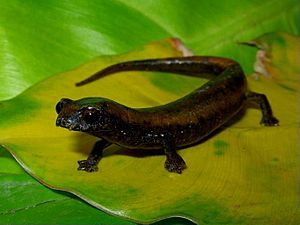Bolitoglossa pandi facts for kids
Quick facts for kids Bolitoglossa pandi |
|
|---|---|
 |
|
| Conservation status | |
| Scientific classification |
The Bolitoglossa pandi is a special kind of salamander. It belongs to the family Plethodontidae, which are salamanders without lungs. This means they breathe through their skin! This salamander is found only in a small part of Colombia, in a region called Cundinamarca Department. It lives in just three known places on the western side of the Eastern Mountains. One of these places is Pandi, which is where it gets its name. Scientists first found this salamander 50 years before they officially described it as a new species in 1963.
Contents
What Does the Pandi Salamander Look Like?
Scientists first described the Bolitoglossa pandi from just one salamander. This was an adult female, and it measured about 50.4 millimeters (about 2 inches) from its snout (nose) to its vent (the opening near its tail). This measurement is called snout-vent length, or SVL.
Later, scientists found more of these salamanders in a place called Supatá. These salamanders ranged from 15 to 53 millimeters in SVL. They noticed that the female salamanders were usually bigger than the males. Adult females were typically between 44.7 and 50.4 millimeters long.
Where Does the Pandi Salamander Live?
The Bolitoglossa pandi lives in cool, wet montane forests. These are forests found high up in the mountains, between 1,300 and 2,200 meters (about 4,265 to 7,218 feet) above sea level.
Daily Life of the Pandi Salamander
Scientists have watched these salamanders in Supatá. At night, they saw them looking for food on small bushes and sitting on leaves. During the day, these salamanders like to hide. They can be found in piles of fallen leaves on the forest floor. They also hide in the leaves of bromeliad plants. Bromeliads are plants that often grow on trees and have cup-like centers that can hold water.
Older, adult salamanders often perch on taller plants than younger ones. Their diet mainly consists of small arthropods. These are tiny creatures with exoskeletons, like insects and spiders. The salamanders especially enjoy eating mites, beetles, and ants.
Why is the Pandi Salamander in Danger?
The Bolitoglossa pandi is not a common species. This means there aren't many of them around. Their biggest threat is the loss of their natural habitat. People are clearing forests for farming, both to grow crops and to raise animals. This destroys the salamanders' homes.
The places where they live are also becoming "fragmented." This means their forest homes are broken up into smaller, separate pieces. This makes it hard for salamanders to move between areas. It also makes it harder for them to find food and mates. Luckily, the group of salamanders in Supatá lives in a small protected area. This helps keep them safe.
See also
 In Spanish: Bolitoglossa pandi para niños
In Spanish: Bolitoglossa pandi para niños


